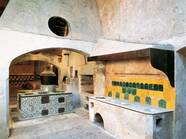The goal of the editorial project ‘50 Top Pizza’ is to create the ultimate global map of quality pizza: a Bible for the pizza lovers of the world if you please. Its curators, economic geographer and food lover Barbara Guerra, sommelier and master cheese and oil taster Albert Sapere, and prominent food and wine writer Luciano Pignataro, are expanding this year’s edition by creating new categories for the top pizzerias outside of Italy.
Their statement reads: “Pizza is a global phenomenon which, without relinquishing its appeal to the masses, is undergoing a significant evolution in terms of quality. We believe, therefore, that it is right to pay tribute to and to spotlight all of those individuals who, throughout the world, have been able to distinguish themselves for the quality of the product they offer.”
This year’s ranking of the 50 Top European Pizzerias gave 1st place to Ciro Salvo’s London venue 50 Kalo (sister to the one in Naples who came in third place in the 2018 Italian ranking); 2nd place was awarded to Bijou, a Parisian restaurant owned by another Neapolitan Gennaro Nasti; and Copenhagen’s Bæst, owned by Sicilian-Danish chef Christian Puglisi, won 3rd place.
Unsurprisingly, England, France and Germany are the three European countries - out of the 23 featured in the list - with the most high quality pizzerias, counting respectively ten, eight, and five.
The nominees for five other international categories were announced: 50 TOP Neapolitan Pizza (out of Italy), 10 TOP Pizza in Africa, 10 TOP Pizza in Asia, 10 TOP Pizza in Oceania, and 10 TOP Pizza in Japan, the results of which will be announced on July 23.
The ranking of the 50 top in North America will be revealed on June 27th during a special event in New York. On this occasion, the nominees for Best Pizzeria in South America and the Best Pizzeria in Brazil will also be announced.
The project does however remain deeply anchored in Italy where the guide counts over 1000 pizzerias. Some of these are already listed online, more will then be revealed later in June, leading up to the grand finale, which will be held on July 23 in the Teatro Mercadante in Naples, the birthplace of pizza. There will take place the much anticipated announcement of Italy’s top 50 pizzerias.
In the past, the winners - and most of the contendants - in fact came from the Campania region. Last year’s top 3 spots were received by Franco Pepe’s Pepe in Grani in Caiazzo; Francesco Martucci’s I Masanielli in Caserta; and 50 Kalo’s Naples location. However, although the traditional Neapolitan style of pizza is certainly prominent, the guide is open to different kinds of pizza, which are featured on the ranking. For example, Simone Padoan’s cutting-edge pizzeria I Tigli, in San Bonifacio, Veneto came in 4th place and Rome’s La Gatta Mangiona was 7th.
Considering this fact, along with the increased opening towards global variations on what is still regarded as a fundamentally Italian dish, it will be interesting to see in which direction this year’s ranking will move, whether it will stick to tradition or hold surprises.







































